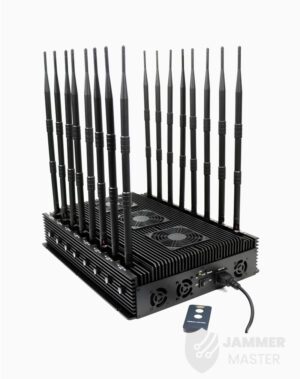
How to Block Drones with a Drone Jammer
In an age where the sky is dotted with drones, the importance of drone jammers has never been more significant. From commercial deliveries to personal
Free Worldwide Shipping & 1-Year Warranty!

With the increasing power and intelligence of mobile phones, the need for Signal Jammer has become more prevalent. These systems are essential in preventing the leakage of sensitive information, especially in places where phone calls and text messages can compromise business confidentiality, such as during important meetings. However, installing Signal Jammer requires meeting specific conditions to ensure accurate and effective signal blocking without causing any unintended consequences.

Full Band Desktop Signal Jammer Block Cellular/WiFi/GPS JM005
$1,365.99
8 Antennas Portable Cell Phone Jammer Block Celluar/WiFi/GPS JM017
$899.00
Desktop 5G Cellular Signal Jammer Block Cellular/Wireless/GPS/LoJack JM006
$1,839.99
Portable Cell Phone Jammer Block Cellular/WiFi/GPS/Walkie Talkie JM008
$659.99The installation of Signal Jammer must prioritize accurate signal blocking without any blind spots or dead zones. This ensures that all mobile devices within the designated area are unable to send or receive signals. To achieve this, the following conditions should be met:
To ensure continuous signal blocking, it is crucial for the wireless signal jamming system to operate with stability. The following conditions should be met:
When installing Signal Jammer in public areas, it is essential to consider the impact on other individuals and their daily activities. The following conditions should be met:
The wireless signal jamming system should only block the necessary areas and not interfere with areas where signal blocking is not required. This ensures that individuals outside the designated areas can continue to use their mobile devices without any disruption.
Conclusion:
Installing Signal Jammer requires meeting specific conditions to ensure accurate and effective signal blocking without causing any unintended consequences. By prioritizing accurate signal blocking, ensuring system stability, considering public areas, and targeting specific areas for signal blocking, organizations can effectively protect sensitive information while maintaining ethical practices in public spaces.
Our frequency checker tool will help you check all frequency bands used in all country.

In an age where the sky is dotted with drones, the importance of drone jammers has never been more significant. From commercial deliveries to personal

Protect your vehicle’s location privacy with a professional guide on GPS jammers. From selection to legal considerations and installation tips, we’ve got you covered. Key

Here’s a step by step guide on how to build your own GPS jammer. Below are the main steps we are going to introduce in

Understanding Signal Blocker: How It Works and Its Applications Signal Blockers are devices that can disrupt mobile phone signals, preventing them from connecting to base

The Application and Benefits of High-Power Signal Jammers Enhancing Signal Blocking Efficiency in Various Environments In today’s technologically advanced world, the need for effective signal

Considerations for Purchasing Exam Room Signal Jammers Ensuring Effective Signal Jamming for Exam Integrity As the year approaches its end, many schools are preparing for

The Importance of Monitoring and Signal Interference Measures During Examinations During examination periods, it is crucial to closely monitor the examination venues and their surrounding

Selecting the Appropriate Cell Phone Jammer for Theaters and Auditoriums Overcoming Challenges in Installation and Maximizing Signal Disruption The Importance of Cell Phone Jamming in

Remote Control of Cell Phone Jammers via Smartphone: A Possibility? With the rapid development of the Internet of Things (IoT), numerous smart home devices have